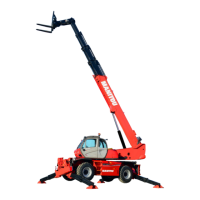1-6
IT EN NL
The user must remain in full control of his lift
truck and should :
- Adapt his speed to each situation in
order to be maintain his own safety,
that of others and of his equipment.
- Always be aware of his stopping
distance.
On the basis of experience, there are a num-
ber of possible situations in which operating
the lift truck is contra-indicated. Such fore-
seeable abnormal uses,
the main ones being listed below, are
strictly forbidden.
- The foreseeable abnormal behavi-
our
resulting from ordinary neglect, but
does not result from any wish to put
the machinery to any improper use.
- The reflex reactions of a person in the
event of a malfunction, incident, fault,
etc. during operation of the lift truck.
- Behaviour resulting from application of
the “principle of least action” when
performing a task.
- For certain machines, the foreseeable
behaviour of such persons as :
apprentices, teenagers, handicapped
persons and trainees tempted to drive
a lift truck. Truck drivers tempted to
operate a truck to win a bet, in
competition or for their own personal
experience.
The person in charge of the equipment must
take these criteria into account when asses-
sing whether or not a person will make a
suitable driver.
- Get to know the telescopic fork lift
truck on the terrain where it is to be
used.
- Transport the load with the boom
lowered and fully retracted
- Position the forks at right-angles to the
load to be lifted.
- Drive the truck at a speed appropriate
to conditions and the state of the
ground.
- Never go too fast or brake sharply with
a load.
- When picking up a load, check that the
ground is as even as possible.
L’utilizzatore deve sempre poter controllare il
carrello elevatore e
quindi deve :
- Adattare la velocità ad ogni situazione
per preservare la propria incolumità,
quella altrui e quella della propria mac-
china.
- Valutare continuamente lo spazio di
frenata.
L’esperienza ci insegna che si possono avere
alcune controindicazioni sull’impiego del
carrello elevatore. Questi impieghi anomali
prevedibili, di cui i principali sono elencati qui
di seguito, sono formalmente vietati.
- Il comportamento anomalo prevedibile,
che risulta da una negligenza ordinaria,
ma che non risulta dalla volontà di fare
un cattivo uso della macchina.
- Il comportamento riflesso di una persona
in caso di cattivo funzionamento, d’inci-
dente, di anomalia, ecc. durante l’utilizzo
del carrello elevatore.
- Il comportamento risultante dall’appli-
cazione della “legge del minimo sforzo”
durante l’esecuzione di un compito.
- Per alcune macchine, il comportamento
prevedibile di certe categorie di persone,
quali: apprendisti, adolescenti, portatori
di handicap, personale in formazione. I
carrellisti tentati di utilizzare il carrello
elevatore per scommesse, competizioni o
per esperienza personale.
Il responsabile dello stabilimento deve tenere
conto di questi criteri per valutare l’attitudine
alla guida di una persona.
- Prendere confidenza con il carrello ele-
vatore telescopico sul terreno dove sarà
utilizzato.
- Trasportare il carico in posizione bassa e il
braccio telescopico rientrato al massimo.
- Posizionare le forche perpendicolarmente
al carico da sollevare.
- Guidare il carrello ad una velocità ade-
guata alle condizioni e allo stato del
terreno.
- Non andare mai troppo forte né frenare
bruscamente con un carico.
- Al momento di prendere un carico, veri-
ficare che il terreno sia il più uniforme
possibile .
De gebruiker moet te allen tijde de macht
over de heftruck behouden, hij moet dus:
- Zijn snelheid aanpassen aan iedere situ-
atie met het oog op zijn eigen veiligheid,
die van anderen en die van zijn machine.
- Altijd de remweg naar behoren weten in
te schatten.
De ervaring heeft ons geleerd dat er bepaalde
contra-indicaties zijn wat betreft het gebruik
van de heftruck. Deze abnormale en voor-
spelbare toepassingen, waarvan de belang-
rijkste hieronder aangegeven zijn, zijn strikt
verboden.
- Abnormaal maar voorspelbaar gedrag
voortvloeiende uit een normale nala-
tigheid welke echter niet ten doel had
de machine op een onjuiste wijze te
gebruiken.
- De onwillekeurige reactie van iemand
in geval van een defecte werking, een
ongeluk, een storing, enz. tijdens het
gebruik van de heftruck.
- Het gedrag dat voortvloeit uit de toepas-
sing van het principe van de «weg van de
minste weerstand» tijdens de uitvoering
van een taak.
- Voor bepaalde machines, het voorspel-
baar gedrag van bepaalde categorieën
van personen, zoals leerlingen, jongeren,
gehandicapten, personen in opleiding.
Heftruckbestuurders die om persoonlijke
redenen de heftruck gebruiken in het
kader van een weddenschap die zij zijn
aangegaan of een wedstrijd.
De verantwoordelijke van het materiaal
moet rekening houden met deze criteria bij
het inschatten van de bekwaamheid van de
personen de heftruck te besturen.
- Raak vertrouwd met de heftruck op het
terrein waarop hij zal worden gebruikt.
- Vervoer de lading in lage stand en met
volledig ingetrokken telescopische arm.
- De vorken loodrecht op de op te heffen
last zetten.
- Rijd met een snelheid die geschikt is voor
de staat van het terrein.
- Nooit te hard rijden of plotseling remmen
als men een lading vervoert.
- Bij het oppakken van een lading, contro-
leren of het terrein wel vlak genoeg is.
649050 IT-EN-NL (01/06/2017)
MRT EASY 55P 400 ST4 S2, MRT EASY 55P 360 ST4 S2, MRT EASY 75P 400 ST3B S2, MRT EASY 75P 360 ST3B S2, MRT-X EASY 75P 400 ST3A S2, MRT-X EASY 75P 360 ST3A S2
